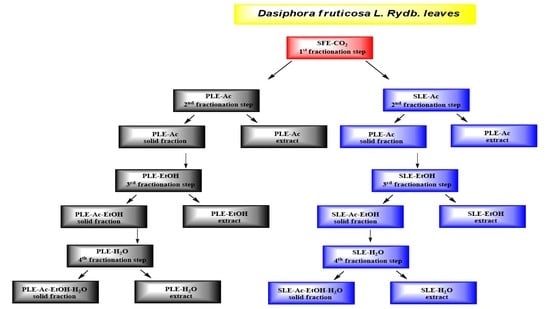High-Pressure Extraction of Antioxidant-Rich Fractions from Shrubby Cinquefoil (Dasiphora fruticosa L. Rydb.) Leaves: Process Optimization and Extract Characterization
Abstract
1. Introduction
2. Materials and Methods
2.1. Plant Material
2.2. Chemicals and Reagents
2.3. Extraction of Non-Polar and Polar Fractions of D. fruticosa
2.3.1. Supercritical Carbon Dioxide Extraction (SFE-CO2)
2.3.2. Pressurized Liquid Extraction (PLE)
2.3.3. Solid–Liquid Extraction (SLE)
2.3.4. Soxhlet Extraction
2.4. In Vitro Antioxidant Capacity of D. fruticosa Extracts and Solid Residues
2.4.1. Total Phenolic Content (TPC) by Folin–Ciocalteu’s Assay
2.4.2. The ABTS•+ Scavenging Assay
2.4.3. The DPPH• Scavenging Assay
2.4.4. Antioxidant Capacity Assessment of Solid Substances
2.5. Chromatographic Analysis of D. fruticosa Extracts
2.5.1. Determination of Fatty Acid Composition
2.5.2. UPLC/ESI-QTOF-MS Analysis of Extracts
2.6. Experimental Design
2.7. Statistical Analysis
3. Results and Discussion
3.1. Yields, Antioxidant Capacity, and Fatty Acid Profile of Lipophilic Substances of D. fruticosa Leaves
3.2. Extraction of Semi-Polar and Polar Constituents from D. fruticosa Leaves
3.2.1. PLE-Ac Optimization and Model Analysis
3.2.2. PLE-EtOH Optimization and Model Analysis
3.2.3. Comparison of the Extraction Efficiency of PLE and Conventional Techniques
3.3. In Vitro Antioxidant Capacity of Polar D. fruticosa Leaves PLE and SLE Extracts
3.4. UPLC-ESI-TOF-MS Analysis of D. fruticosa Leaves PLE Extracts
4. Conclusions
Supplementary Materials
Author Contributions
Funding
Acknowledgments
Conflicts of Interest
References
- Saeidnia, S.; Abdollahi, M. Toxicological and pharmacological concerns on oxidative stress and related diseases. Toxicol. Appl. Pharmacol. 2013, 273, 442–455. [Google Scholar] [CrossRef] [PubMed]
- Li, A.-N.; Li, S.; Zhang, Y.-J.; Xu, X.-R.; Chen, Y.-M.; Li, H.-B. Resources and biological activities of natural polyphenols. Nutrients 2014, 6, 6020–6047. [Google Scholar] [CrossRef] [PubMed]
- Silva, R.F.M.; Pogačnik, L. Polyphenols from food and natural products: Neuroprotection and safety. Antioxidants 2020, 9, 61. [Google Scholar] [CrossRef] [PubMed]
- Mlcek, J.; Rop, O. Fresh edible flowers of ornamental plants—A new source of nutraceutical foods. Trends Food Sci. Technol. 2011, 22, 561–569. [Google Scholar] [CrossRef]
- Miliauskas, G.; Venskutonis, P.R.; van Beek, T.A. Screening of radical scavenging activity of some medicinal and aromatic plant extracts. Food Chem. 2004, 85, 231–237. [Google Scholar] [CrossRef]
- Miliauskas, G.; van Beek, T.A.; Venskutonis, P.R.; Linssen, J.P.H.; de Waard, P.; Sudhölter, E.J. Antioxidant activity of Potentilla fruticosa. J. Sci. Food Agric. 2004, 84, 1997–2009. [Google Scholar] [CrossRef]
- Wang, S.-S.; Wang, D.-M.; Pu, W.-J.; Li, D.-W. Phytochemical profiles, antioxidant and antimicrobial activities of three Potentilla species. BMC Complement. Altern. Med. 2013, 13, 321. [Google Scholar] [CrossRef] [PubMed]
- Tomczyk, M.; Latté, K.P. Potentilla—A review of its phytochemical and pharmacological profile. J. Ethnopharmacol. 2009, 122, 184–204. [Google Scholar] [CrossRef] [PubMed]
- Luo, Z.; Wang, S.; Wang, D. Phenolic profiles and antioxidant capacities of crude extracts and subsequent fractions from Potentilla fruticosa L. leaves. Nat. Prod. Res. 2016, 30, 1890–1895. [Google Scholar] [CrossRef] [PubMed]
- Jurkštienė, V.; Pavilonis, A.; Garšvienė, D.; Juozulynas, A.; Samsonienė, L.; Daukšienė, D.; Jankauskienė, K.; Šimonienė-Kazlauskienė, G.; Stankevičius, E. Investigation of the antimicrobial activity of rhaponticum (rhaponticum carthamoides D.C. iljin) and shrubby cinquefoil (Potentilla fruticosa L.). Med. Buenos Aires 2011, 47, 24. [Google Scholar] [CrossRef]
- Pu, W.J.; Li, D.W.; Wang, D.M. Potentilla fruticosa extracts as antimicrobials in post-harvest storage of fruits. Allelopath. J. 2014, 34, 59–70. [Google Scholar]
- Liu, Z.; Luo, Z.; Jia, C.; Wang, D.; Li, D. Synergistic effects of Potentilla fruticosa L. leaves combined with green tea polyphenols in a variety of oxidation systems. J. Food Sci. 2016, 81, C1091–C1101. [Google Scholar] [CrossRef] [PubMed]
- Liu, Z.-H.; Wang, D.-M.; Fan, S.-F.; Li, D.-W.; Luo, Z.-W. Synergistic effects and related bioactive mechanism of Potentilla fruticosa L. leaves combined with Ginkgo biloba extracts studied with microbial test system (MTS). BMC Complement. Altern. Med. 2016, 16, 495. [Google Scholar] [CrossRef] [PubMed]
- Wang, S.; Wang, D.; Liu, Z. Synergistic, additive and antagonistic effects of Potentillafruticosa combined with EGb761 on antioxidant capacities and the possible mechanism. Ind. Crop. Prod. 2015, 67, 227–238. [Google Scholar] [CrossRef]
- Cavaiuolo, M.; Cocetta, G.; Ferrante, A. The antioxidants changes in ornamental flowers during development and senescence. Antioxidants 2013, 2, 132–155. [Google Scholar] [CrossRef]
- Liu, W.; Wang, D.; Hou, X.; Yang, Y.; Xue, X.; Jia, Q.; Zhang, L.; Zhao, W.; Yin, D. Effects of growing location on the contents of main active components and antioxidant activity of dasiphora fruticosa (L.) rydb. by chemometric methods. Chem. Biodivers. 2018, 15, e1800114. [Google Scholar] [CrossRef]
- Liu, W.; Yin, D.; Li, N.; Hou, X.; Wang, D.; Li, D.; Liu, J. Influence of environmental factors on the active substance production and antioxidant activity in potentilla fruticosa L. and its quality assessment. Sci. Rep. 2016, 6, 28591. [Google Scholar] [CrossRef]
- Huie, C.W. A review of modern sample-preparation techniques for the extraction and analysis of medicinal plants. Anal. Bioanal. Chem. 2002, 373, 23–30. [Google Scholar] [CrossRef]
- Xu, D.-P.; Li, Y.; Meng, X.; Zhou, T.; Zhou, Y.; Zheng, J.; Zhang, J.-J.; Li, H.-B. Natural antioxidants in foods and medicinal plants: Extraction, assessment and resources. Int. J. Mol. Sci. 2017, 18, 96. [Google Scholar] [CrossRef]
- Bendif, H.; Adouni, K.; Miara, M.D.; Baranauskienė, R.; Kraujalis, P.; Venskutonis, P.R.; Nabavi, S.M.; Maggi, F. Essential oils (EOs), pressurized liquid extracts (PLE) and carbon dioxide supercritical fluid extracts (SFE-CO2) from Algerian Thymus munbyanus as valuable sources of antioxidants to be used on an industrial level. Food Chem. 2018, 260, 289–298. [Google Scholar] [CrossRef]
- Kemzūraitė, A.; Venskutonis, P.R.; Baranauskienė, R.; Navikienė, D. Optimization of supercritical CO2 extraction of different anatomical parts of lovage (Levisticum officinale Koch.) using response surface methodology and evaluation of extracts composition. J. Supercrit. Fluids 2014, 87, 93–103. [Google Scholar] [CrossRef]
- Grauzdytė, D.; Pukalskas, A.; El Kalamouni, C.; Venskutonis, P.R. Antioxidant potential and phytochemical composition of extracts obtained from Phyllanthus phillyreifolius by different extraction methods. Nat. Prod. Res. 2020, 34, 706–709. [Google Scholar] [CrossRef]
- Singleton, V.L.; Orthofer, R.; Lamuela-Raventós, R.M. Analysis of total phenols and other oxidation substrates and antioxidants by means of folin-ciocalteu reagent. Methods Enzymol. 1998, 299, 152–178. [Google Scholar]
- Re, R.; Pellegrini, N.; Proteggente, A.; Pannala, A.; Yang, M.; Rice-Evans, C. Antioxidant activity applying an improved ABTS radical cation decolorization assay. Free Radic. Biol. Med. 1999, 26, 1231–1237. [Google Scholar] [CrossRef]
- Brand-Williams, W.; Cuvelier, M.E.; Berset, C. Use of a free radical method to evaluate antioxidant activity. LWT—Food Sci. Technol. 1995, 28, 25–30. [Google Scholar] [CrossRef]
- Gökmen, V.; Serpen, A.; Fogliano, V. Direct measurement of the total antioxidant capacity of foods: The ‘QUENCHER’ approach. Trends Food Sci. Technol. 2009, 20, 278–288. [Google Scholar] [CrossRef]
- Kitrytė, V.; Narkevičiūtė, A.; Tamkutė, L.; Syrpas, M.; Pukalskienė, M.; Venskutonis, P.R. Consecutive high-pressure and enzyme assisted fractionation of blackberry (Rubus fruticosus L.) pomace into functional ingredients: Process optimization and product characterization. Food Chem. 2020, 312, 126072. [Google Scholar] [CrossRef] [PubMed]
- Kitrytė, V.; Laurinavičienė, A.; Syrpas, M.; Pukalskas, A.; Venskutonis, P.R. Modeling and optimization of supercritical carbon dioxide extraction for isolation of valuable lipophilic constituents from elderberry (Sambucus nigra L.) pomace. J. CO2 Util. 2020, 35, 225–235. [Google Scholar] [CrossRef]
- Syrpas, M.; Bukauskaitė, J.; Paškauskas, R.; Bašinskienė, L.; Venskutonis, P.R. Recovery of lipophilic products from wild cyanobacteria (Aphanizomenon flos-aquae) isolated from the Curonian Lagoon by means of supercritical carbon dioxide extraction. Algal Res. 2018, 35, 10–21. [Google Scholar] [CrossRef]
- Azmir, J.; Zaidul, I.S.M.; Rahman, M.M.; Sharif, K.M.; Mohamed, A.; Sahena, F.; Jahurul, M.H.A.; Ghafoor, K.; Norulaini, N.A.N.; Omar, A.K.M. Techniques for extraction of bioactive compounds from plant materials: A review. J. Food Eng. 2013, 117, 426–436. [Google Scholar] [CrossRef]
- Kas’yanov, G.I.; Shaftan, É.A.; Klimova, E.S. An investigation of CO2 extracts from the roots and rhizomes of Potentilla erecta and Archangelica officinalis. Chem. Nat. Compd. 1977, 13, 94–95. [Google Scholar]
- Giacometti, J.; Bursać Kovačević, D.; Putnik, P.; Gabrić, D.; Bilušić, T.; Krešić, G.; Stulić, V.; Barba, F.J.; Chemat, F.; Barbosa-Cánovas, G.; et al. Extraction of bioactive compounds and essential oils from mediterranean herbs by conventional and green innovative techniques: A review. Food Res. Int. 2018, 113, 245–262. [Google Scholar] [CrossRef] [PubMed]
- Yu, D.; Pu, W.; Li, D.; Wang, D.; Liu, Q.; Wang, Y. Phenolic compounds and antioxidant activity of different organs of Potentilla fruticosa L. from two main production areas of China. Chem. Biodivers. 2016, 13, 1140–1148. [Google Scholar] [CrossRef] [PubMed]
- Tomczyk, M.; Pleszczyńska, M.; Wiater, A. Variation in total polyphenolics contents of aerial parts of potentilla species and their anticariogenic activity. Molecules 2010, 15, 4639–4651. [Google Scholar] [CrossRef]
- Xue, P.; Zhao, Y.; Wang, B.; Liang, H. Simultaneous determination of seven flavonoids in potentilla multifida by HPLC. J. Chromatogr. Sci. 2007, 45, 216–219. [Google Scholar] [CrossRef][Green Version]
- Tomczyk, M.; Bazylko, A.; Bonarewicz, J. Method development and validation for optimized separation of quercetin derivatives in selected Potentilla species using high-performance thin-layer chromatography photodensitometry method. J. Pharm. Biomed. Anal. 2012, 61, 265–270. [Google Scholar] [CrossRef]
- Xue, P.-F.; Zhao, Y.-Y.; Wang, B.; Liang, H. Secondary metabolites from Potentilla discolor Bunge (Rosaceae). Biochem. Syst. Ecol. 2006, 34, 825–828. [Google Scholar] [CrossRef]
- Gao, W.; Shen, Y.; Zhang, H.-J.; Tang, H.; Lin, H.-W.; Qiu, F. The chemical constituents of Potentilla chinensis. Pharm. Care Res. 2007, 7, 262–264. [Google Scholar]
- Okuda, T.; Yoshida, T.; Hatano, T.; Iwasaki, M.; Kubo, M.; Orime, T.; Yoshizaki, M.; Naruhashi, N. Hydrolysable tannins as chemotaxonomic markers in the rosaceae. Phytochemistry 1992, 31, 3091–3096. [Google Scholar] [CrossRef]
- Wollenweber, E.; Dörr, M. Flavonoid aglycones from the lipophilic exudates of some species of Rosaceae. Biochem. Syst. Ecol. 2008, 36, 481–483. [Google Scholar] [CrossRef]
- Ganenko, T.V.; Lutskii, B.I.; Larin, M.F.; Vereshchagin, A.L.; Semenov, A.A. Chemical composition of Potentilla fruticosa. I. Flavonoids. Chem. Nat. Compd. 1988, 24, 387–388. [Google Scholar] [CrossRef]
- Kombal, R.; Glasl, H. Flavan-3-ols and flavonoids from Potentilla anserina. Planta Med. 1995, 61, 484–485. [Google Scholar] [CrossRef] [PubMed]
- Ganenko, T.V.; Semenov, A.A. Chemical composition of Potentilla fruticosa. II. Triterpenoids. Chem. Nat. Compd. 1989, 25, 727. [Google Scholar] [CrossRef]
- Zhang, N.; Ying, M.-D.; Wu, Y.-P.; Zhou, Z.-H.; Ye, Z.-M.; Li, H.; Lin, D.-S. Hyperoside, a flavonoid compound, inhibits proliferation and stimulates osteogenic differentiation of human osteosarcoma cells. PLoS ONE 2014, 9, e98973. [Google Scholar] [CrossRef]
- Landete, J.M. Ellagitannins, ellagic acid and their derived metabolites: A review about source, metabolism, functions and health. Food Res. Int. 2011, 44, 1150–1160. [Google Scholar] [CrossRef]
- Fernandes, I.; Pérez-Gregorio, R.; Soares, S.; Mateus, N.; de Freitas, V. Wine flavonoids in health and disease prevention. Molecules 2017, 22, 292. [Google Scholar] [CrossRef]
- Rees, A.; Dodd, G.; Spencer, J. The effects of flavonoids on cardiovascular health: A review of human intervention trials and implications for cerebrovascular function. Nutrients 2018, 10, 1852. [Google Scholar] [CrossRef]
- Mlala, S.; Oyedeji, A.O.; Gondwe, M.; Oyedeji, O.O. Ursolic acid and its derivatives as bioactive agents. Molecules 2019, 24, 2751. [Google Scholar] [CrossRef]
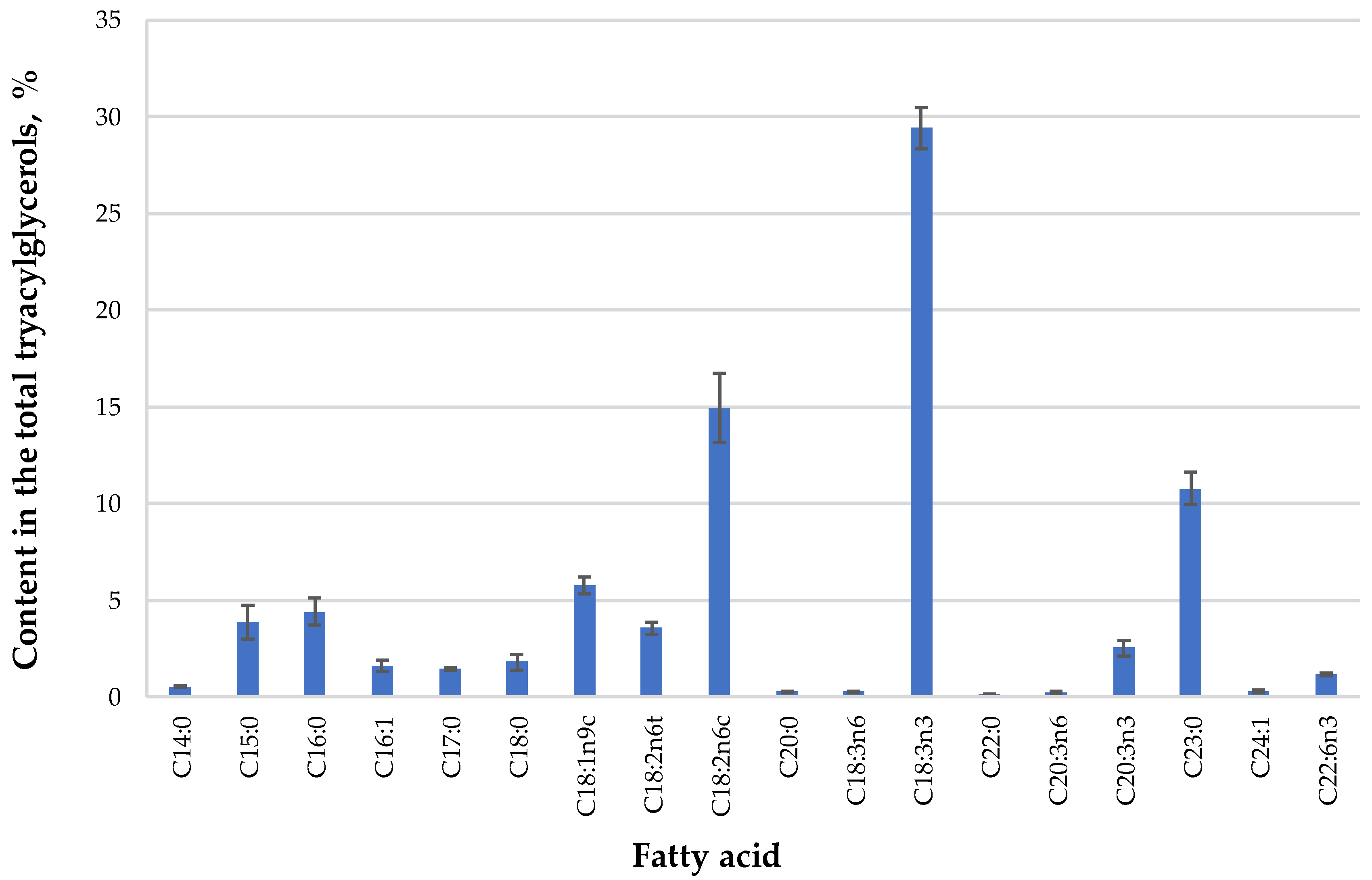

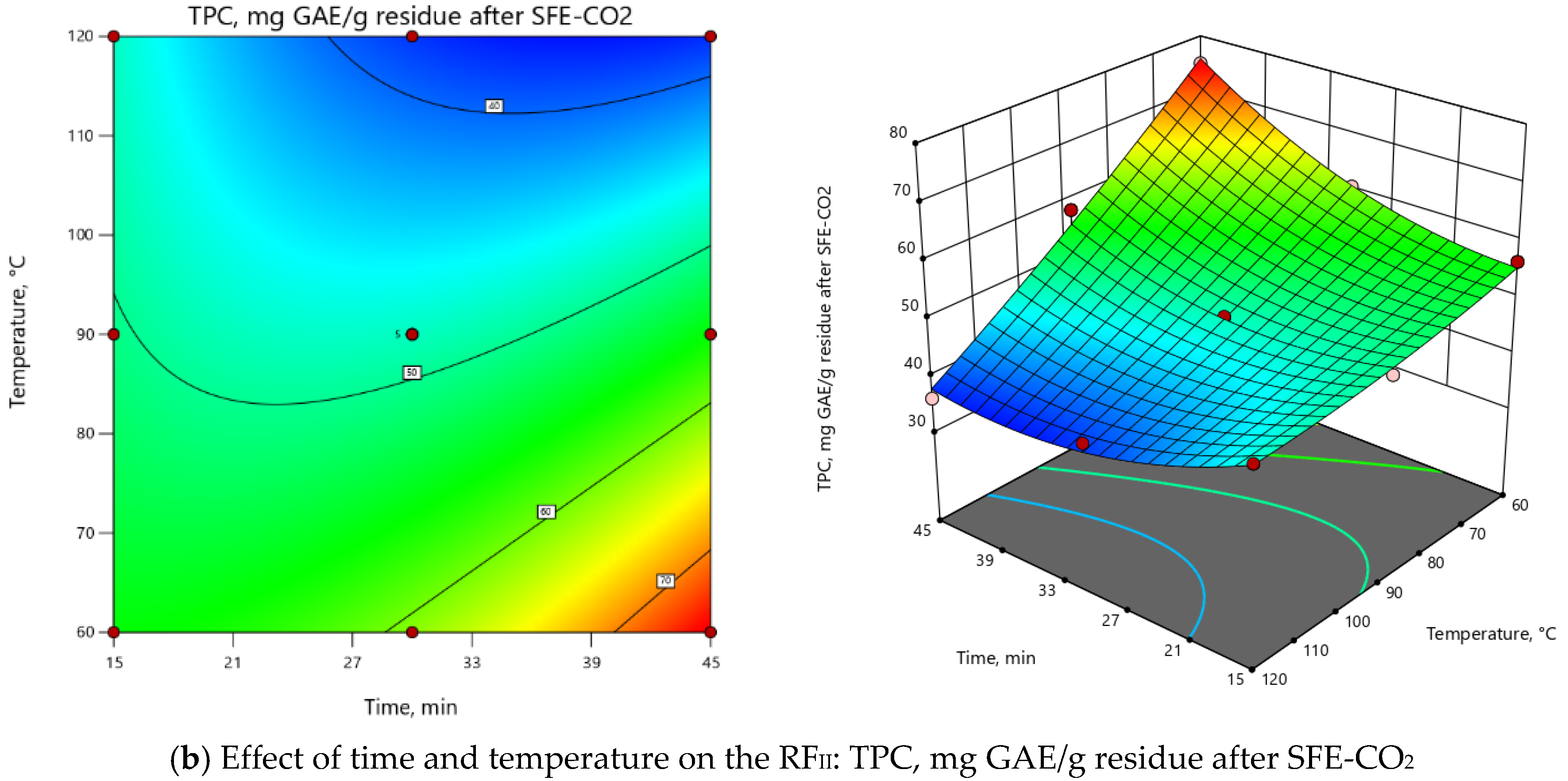
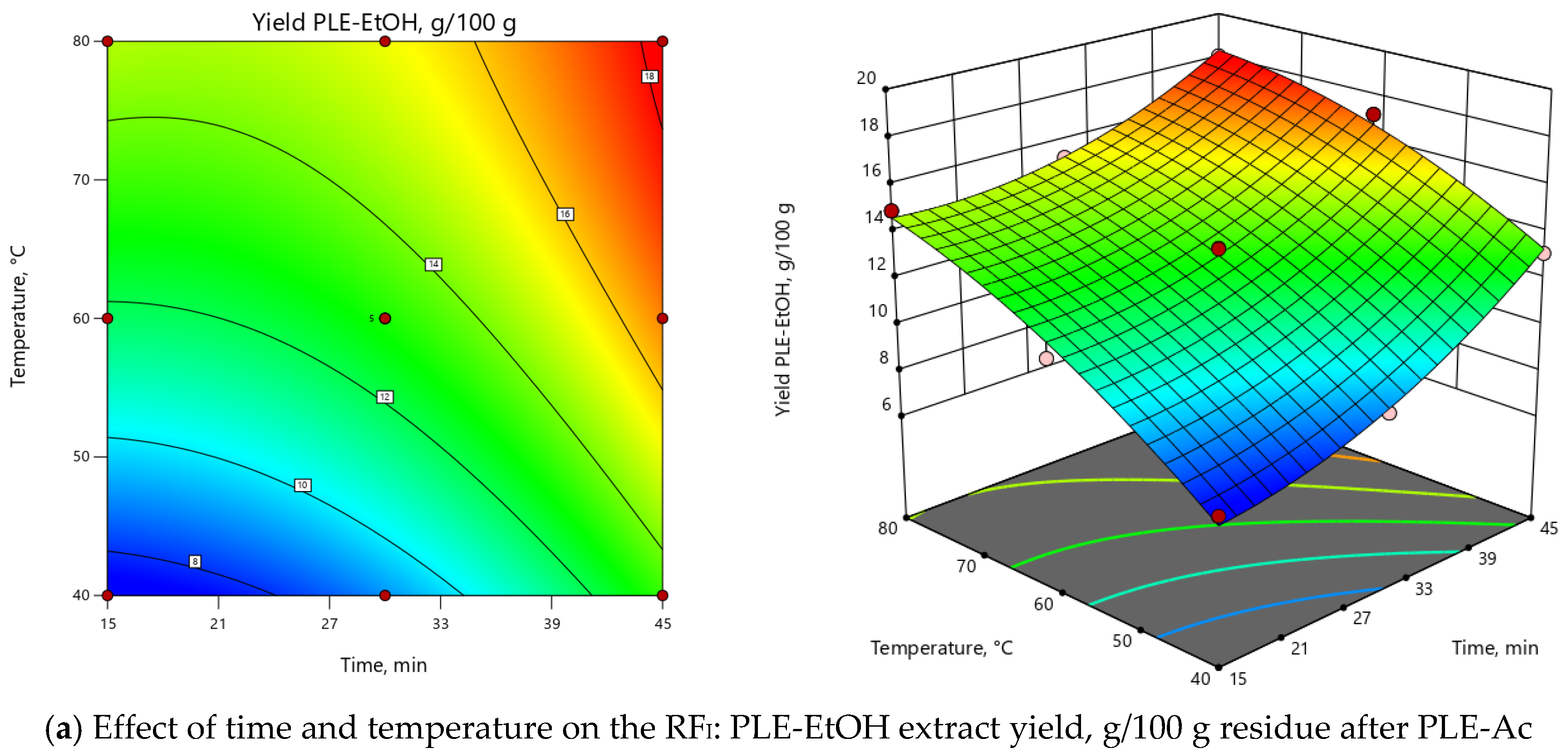
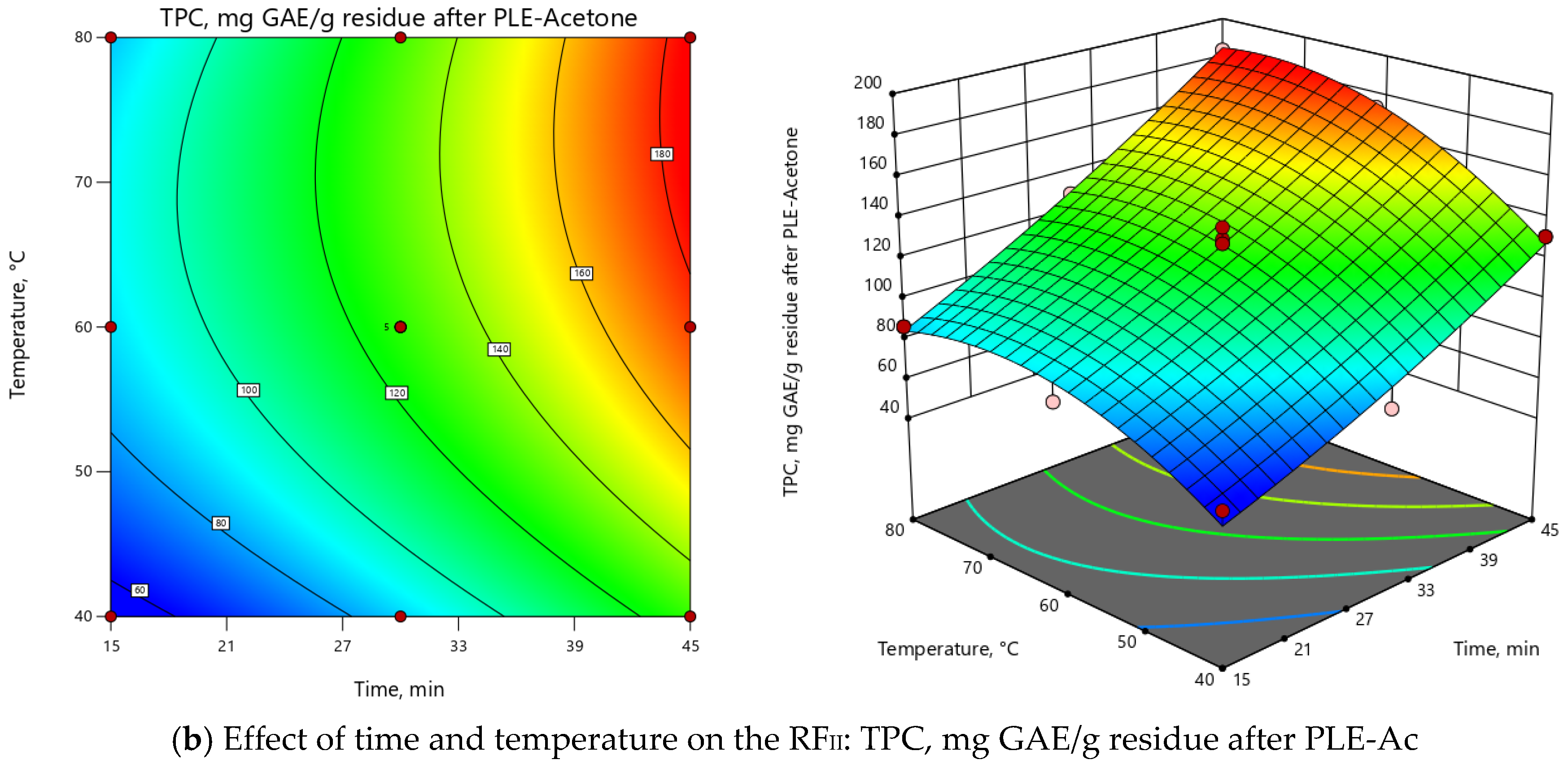
| Sample | Yield, g/100 g DW 1 | TPC, mg GAE/g DW 1 | TEACABTS, mg TE/g DW 1 | TEACDPPH, mg TE/g DW 1 |
|---|---|---|---|---|
| Starting plant material | -na | 200.57 ± 4.30 a | 255.84 ± 8.65 b | 164.50 ± 8.14 a |
| Residue after SFE-CO2 2 | 97.54 * | 228.49 ± 5.28 b | 247.37 ± 4.43 ab | 183.63 ± 5.00 b |
| Residue after Soxhlet-He 3 | 97.32 * | 194.47 ± 3.88 a | 232.83 ± 13.43 a | 153.38 ± 7.68 a |
| Levels and Runs | Extraction Variables | PLE-Ac Yield, g/100 g * | TPC, mg GAE/g ** | |
|---|---|---|---|---|
| τ, min | T, °C | |||
| Low level (−1) | 15 | 60 | ||
| Medium level (0) | 30 | 90 | ||
| Max level (+1) | 45 | 120 | ||
| 1 (central) | 30 | 90 | 12.45 ± 0.07 | 46.41 ± 0.81 |
| 2 (central) | 30 | 90 | 12.61 ± 0.42 | 47.78 ± 0.60 |
| 3 (central) | 30 | 90 | 12.69 ± 0.12 | 48.49 ± 0.18 |
| 4 (factorial) | 30 | 60 | 9.98 ± 0.11 | 60.69 ± 0.50 |
| 5 (axial) | 15 | 60 | 7.05 ± 0.60 | 56.48 ± 0.37 |
| 6 (axial) | 45 | 60 | 11.00 ± 0.20 | 75.02 ± 0.27 |
| 7 (axial) | 45 | 120 | 16.47 ± 0.19 | 36.05 ± 0.05 |
| 8 (factorial) | 45 | 90 | 14.32 ± 0.80 | 58.15 ± 0.58 |
| 9 (axial) | 15 | 120 | 14.20 ± 0.50 | 48.29 ± 0.68 |
| 10 (central) | 30 | 90 | 12.54 ± 0.80 | 48.55 ± 0.63 |
| 11 (factorial) | 30 | 120 | 15.37 ± 0.40 | 39.69 ± 0.10 |
| 12 (factorial) | 15 | 90 | 10.30 ± 0.39 | 49.22 ± 0.16 |
| 13 (central) | 30 | 90 | 12.01 ± 0.13 | 48.71 ± 0.71 |
| Levels and Runs | Extraction Variables | PLE-EtOH Yield, g/100 g * | TPC, mg GAE/g ** | |
|---|---|---|---|---|
| τ, min | T, °C | |||
| Low level (−1) | 15 | 40 | ||
| Medium level (0) | 30 | 60 | ||
| Max level (+1) | 45 | 80 | ||
| 1 (central) | 30 | 60 | 12.90 ± 0.33 | 130.13 ± 3.16 |
| 2 (factorial) | 30 | 40 | 8.84 ± 0.30 | 75.64 ± 0.43 |
| 3 (central) | 30 | 60 | 13.37 ± 0.25 | 125.66 ± 1.60 |
| 4 (axial) | 15 | 80 | 14.94 ± 0.40 | 86.63 ± 0.49 |
| 5 (axial) | 15 | 40 | 7.52 ± 0.45 | 60.57 ± 2.50 |
| 6 (factorial) | 15 | 60 | 11.10 ± 1.63 | 78.92 ± 2.93 |
| 7 (central) | 30 | 60 | 13.01 ± 0.13 | 127.91 ± 5.71 |
| 8 (factorial) | 30 | 80 | 15.25 ± 0.36 | 129.03 ± 3.26 |
| 9 (axial) | 45 | 40 | 13.13 ± 0.60 | 131.33 ± 0.40 |
| 10 (central) | 30 | 60 | 12.83 ± 0.35 | 135.99 ± 5.73 |
| 11 (factorial) | 45 | 60 | 17.16 ± 0.80 | 173.20 ± 0.37 |
| 12 (central) | 30 | 60 | 13.32 ± 0.25 | 127.89 ± 3.95 |
| 13 (axial) | 45 | 80 | 18.06 ± 0.30 | 183.46 ± 1.19 |
| Sample | Yield, g/100 g DW 1 | TPC | TEACABTS | TEACDPPH | |||
|---|---|---|---|---|---|---|---|
| mg GAE/g Sample 2 | mg GAE/g DW 1 | mg TE/g Sample 2 | mg TE/g DW 1 | mg TE/g Sample 2 | mg TE/g DW 1 | ||
| Polar extracts (from the residue after SFE-CO2) | |||||||
| Sequential high-pressure extraction 3: | |||||||
| PLE-Ac (62 °C, 45 min) | 11.38 ± 0.12 c | 650.87 ± 16.45 f | 74.07 ± 1.87 e | 1402.01 ± 41.39 f | 159.55 ± 4.71 g | 758.57 ± 16.88 f | 86.33 ± 1.92 e |
| PLE-EtOH (75 °C, 45 min) | 15.30 ± 0.33 e | 969.93 ± 18.57 h | 148.40 ± 2.84 g | 1085.59 ± 30.45 e | 166.09 ± 4.66 g | 992.25 ± 16.01 h | 151.81 ± 2.45 i |
| PLE-H2O (130 °C, 45 min) | 13.76 ± 0.44 d | 227.91 ± 5.05 d | 31.36 ± 0.69 cd | 363.65 ± 7.34 c | 50.04 ± 1.01 d | 258.96 ± 6.09 d | 35.63 ± 0.84 c |
| Sequential conventional extraction 4: | |||||||
| SLE-Ac (40 °C, 360 min) | 6.79 ± 0.02 a | 565.62 ± 10.11 e | 38.39 ± 0.69 d | 1533.87 ± 89.22 g | 104.10 ± 6.05 e | 837.62 ± 24.76 g | 56.85 ± 1.68 d |
| SLE-EtOH (60 °C, 360 min) | 14.86 ± 0.04 e | 822.38 ± 23.85 g | 122.18 ± 3.54 f | 750.34 ± 21.55 d | 111.48 ± 3.20 e | 651.75 ± 22.41 e | 96.83 ± 3.33 f |
| SLE-H2O (60 °C, 360 min) | 8.33 ± 0.02 b | 181.80 ± 11.65 c | 15.14 ± 0.97 b | 208.75 ± 10.90 b | 17.38 ± 0.91 b | 191.08 ± 4.82 c | 15.91 ± 0.40 b |
| Solid fractions (from the residue after SFE-CO2): | |||||||
| Sequential high-pressure extraction 3: | |||||||
| Residue after PLE-Ac | 86.16 * | 187.11 ± 9.68 c | 161.21 ± 8.34 h | 149.41 ± 5.82 b | 128.73 ± 5.02 f | 136.91 ± 11.18 b | 117.96 ± 9.63 h |
| Residue after PLE-Ac-EtOH | 70.86 ** | 36.17 ± 1.98 b | 25.57 ± 1.40 c | 43.46 ± 1.69 a | 30.79 ± 1.20 c | 23.40 ± 0.62 a | 16.58 ± 0.44 b |
| Residue after PLE-Ac-EtOH-H2O | 57.10 *** | 5.46 ± 0.03 a | 3.12 ± 0.02 a | 2.34 ± 0.12 a | 1.34 ± 0.07 a | 2.07 ± 0.17 a | 1.18 ± 0.10 a |
| Sequential conventional extraction 4: | |||||||
| Residue after SLE-Ac | 90.75 * | 177.20 ± 5.28 c | 160.81 ± 4.79 h | 136.39 ± 1.24 b | 123.77 ± 1.12 f | 117.82 ± 6.26 b | 106.92 ± 5.68 g |
| Residue after SLE-Ac-EtOH | 75.89 ** | 34.55 ± 0.59 b | 26.22 ± 0.45 c | 25.67 ± 1.52 a | 19.48 ± 1.15 b | 22.59 ± 2.07 a | 17.15 ± 1.57 b |
| Residue after SLE-Ac-EtOH-H2O | 67.56 *** | 5.79 ± 0.06 a | 3.91 ± 0.04 a | 3.50 ± 0.27 a | 2.36 ± 0.18 a | 2.32 ± 0.21 a | 1.57 ± 0.14 a |
| R.T, min | Meas. Mass, m/z | Δ-ppm | Suggested Formula | Adduct | Tentative Identification | PLE Extracts | Reference | ||
|---|---|---|---|---|---|---|---|---|---|
| PLE-Ac | PLE-EtOH | PLE-H2O | |||||||
| 0.3–0.4 | 179.0560 | 0 | C6H11O6 | M-H | monosaccharide | + | + | + | |
| 0.3–0.4 | 195.0511 | 0 | C6H11O7 | M-H | gluconic acid | - | - | + | |
| 0.3–0.4 | 215.0325 | 11 | C12H8O4 | M-H | bergapten | + | + | - | |
| 0.3–0.4 | 269.0877 | 21 | C15H9O5 | M-H | apigenin | + | - | - | [35] |
| 0.3–0.4 | 387.1143 | 14 | C20H19O8 | M-H | unknown flavonoid | + | + | + | |
| 0.4–0.4 | 191.0562 | 0 | C7H11O6 | M-H | quinic acid | - | + | + | |
| 0.4–0.4 | 341.1086 | 0 | C12H21O11 | M-H | disaccharide | + | + | - | |
| 0.4–0.4 | 377.0854 | 6 | C18H17O9 | M-H | unknown | - | + | - | |
| 0.4–0.5 | 133.0142 | 0 | C4H5O5 | M-H | malic acid | - | - | + | |
| 0.6–0.6 | 481.0622 | 0 | C20H17O14 | M-H | quercetin-glucuronopyranoside | - | - | + | [6,36] |
| 0.7–0.8 | 191.0198 | 0 | C6H7O7 | M-H | citric acid | - | - | + | |
| 0.9–0.9 | 217.0354 | 0 | C7H3N7O2 | M-H | unknown | - | - | + | |
| 1.0–1.0 | 169.0142 | 0 | C7H5O5 | M-H | gallic acid | - | - | + | [37,38] |
| 1.6–1.7 | 483.0784 | 0 | C20H19O14 | M-H | digalloyl glycoside | - | + | - | |
| 1.7–1.8 | 289.0718 | 0 | C15H13O6 | M-H | catechin | + | + | + | [6,9] |
| 1.7–1.8 | 353.0877 | 0 | C16H17O9 | M-H | chlorogenic acid | - | + | + | [39] |
| 1.7–1.8 | 579.1507 | 0 | C30H27O12 | M-H | unknown flavonoid glycoside | + | + | - | |
| 1.7–1.8 | 643.1667 | 0 | C31H31O15 | M-H20 | kaempferol glycoside | - | + | - | |
| 1.8–1.9 | 291.0148 | 1 | C13H7O8 | M-H | unknown | - | - | + | |
| 1.9–2.0 | 165.0193 | 0 | C8H5O4 | M-H | hydroxybenzoic acid | + | + | - | |
| 1.9–2.0 | 327.1083 | 0 | C15H19O8 | M-H | luteolin-trimethyl ether | + | + | - | [40] |
| 1.9–2.0 | 577.1347 | 0 | C30H25O12 | M-H | apigenin-(coumaroyl)-glucoside (terniflorin) | + | + | + | [41] |
| 1.9–2.0 | 635.0889 | 0 | C27H23O18 | M-H | gallotannin | + | + | - | |
| 1.9–2.0 | 865.1980 | 0 | C30H26O13 | M-H | unknown | + | - | - | |
| 2.2–2.3 | 576.1272 | 0 | C30H26O13 | M-H20 | unknown flavonoid glycoside | + | - | - | |
| 2.2–2.3 | 609.1458 | 0 | C27H29O16 | M-H | quercetin-rutinoside (rutin) | + | + | - | [6,36] |
| 2.2–2.3 | 615.0988 | 0 | C28H23O16 | M-H | unknown flavonoid glycoside | + | + | - | - |
| 2.3–2.3 | 463.0880 | 0 | C21H19O12 | M-H | quercetin-galactoside (hyperoside) | + | + | + | [7,9,33,36] |
| 2.3–2.4 | 300.9987 | 0 | C14H5O8 | M-H | ellagic acid | + | + | + | [6,9] |
| 2.3–2.4 | 477.0674 | 0 | C21H17O13 | M-H | quercetin-galacturonide/-glucuronide | + | + | + | |
| 2.5–2.6 | 319.0456 | 1 | C15H11O8 | M-H | dihydromyricetin | - | + | - | |
| 2.6–2.7 | 433.0771 | 0 | C20H17O11 | M-H | quercetin-arabinofuranoside (avicularin) | + | + | - | [41] |
| 2.6–2.7 | 451.1035 | 0 | C24H19O9 | M-H | epigallocatechin-coumarate | + | - | - | |
| 3.1–3.1 | 485.1094 | 0 | C24H21O11 | M-H | epigallocatechin-dimethylgallate | - | + | - | |
| 3.1–3.1 | 521.0856 | 15 | C23H21O14 | M-H | unknown flavonoid glycoside | - | + | - | |
| 3.1–3.1 | 614.2514 | 0 | C36H38O9 | M-H | unknown | + | + | - | |
| 3.1–3.1 | 720.1593 | 0 | C38H28N2O13 | M-H | unknown | + | + | - | |
| 3.2–3.2 | 477.1040 | 0 | C22H21O12 | M-H | rhamnetin-glucopyranoside | + | + | + | [6] |
| 3.2–3.2 | 593.1308 | 1 | C30H25O13 | M-H | kaempferol-rutinoside | + | + | + | [6] |
| 3.2–3.3 | 491.0833 | 0 | C22H19O13 | M-H | isorhamnetin-glucuronide | - | - | + | [42] |
| 3.3–3.4 | 447.0938 | 1 | C21H19O11 | M-H | quercitrin/astragalin | + | + | - | [42] |
| 3.3–3.4 | 628.267 | 0 | C37H40O9 | M-H | unknown | + | - | - | |
| 3.9–4.0 | 329.2336 | 0 | C18H33O5 | M-H | tricin/rhamnatin | + | - | - | |
| 5.0–5.1 | 487.3431 | 0 | C30H47O5 | M-H | tormentic acid | + | - | - | [43] |
| 5.0–5.1 | 533.3489 | 0 | C30H43N7O2 | M-H | unknown | + | - | - | |
| 5.7–5.8 | 485.3276 | 0 | C30H45O5 | M-H | unknown | + | - | - | |
| 5.7–5.8 | 531.3332 | 0 | C31H47O7 | M-H | unknown | + | - | - | |
| 6.3–6.3 | 471.3483 | 0 | C30H47O4 | M-H | hydroxyursolic acid | + | - | - | [43] |
| 6.3–6.3 | 517.3537 | 0 | C31H49O6 | M-H | unknown | + | - | - | |
| 6.3–6.3 | 943.7025 | 1 | C60H95O8 | M-H | glycerolipid | + | - | - | |
© 2020 by the authors. Licensee MDPI, Basel, Switzerland. This article is an open access article distributed under the terms and conditions of the Creative Commons Attribution (CC BY) license (http://creativecommons.org/licenses/by/4.0/).
Share and Cite
Syrpas, M.; Subbarayadu, K.; Kitrytė, V.; Venskutonis, P.R. High-Pressure Extraction of Antioxidant-Rich Fractions from Shrubby Cinquefoil (Dasiphora fruticosa L. Rydb.) Leaves: Process Optimization and Extract Characterization. Antioxidants 2020, 9, 457. https://doi.org/10.3390/antiox9060457
Syrpas M, Subbarayadu K, Kitrytė V, Venskutonis PR. High-Pressure Extraction of Antioxidant-Rich Fractions from Shrubby Cinquefoil (Dasiphora fruticosa L. Rydb.) Leaves: Process Optimization and Extract Characterization. Antioxidants. 2020; 9(6):457. https://doi.org/10.3390/antiox9060457
Chicago/Turabian StyleSyrpas, Michail, Kiran Subbarayadu, Vaida Kitrytė, and Petras Rimantas Venskutonis. 2020. "High-Pressure Extraction of Antioxidant-Rich Fractions from Shrubby Cinquefoil (Dasiphora fruticosa L. Rydb.) Leaves: Process Optimization and Extract Characterization" Antioxidants 9, no. 6: 457. https://doi.org/10.3390/antiox9060457
APA StyleSyrpas, M., Subbarayadu, K., Kitrytė, V., & Venskutonis, P. R. (2020). High-Pressure Extraction of Antioxidant-Rich Fractions from Shrubby Cinquefoil (Dasiphora fruticosa L. Rydb.) Leaves: Process Optimization and Extract Characterization. Antioxidants, 9(6), 457. https://doi.org/10.3390/antiox9060457






